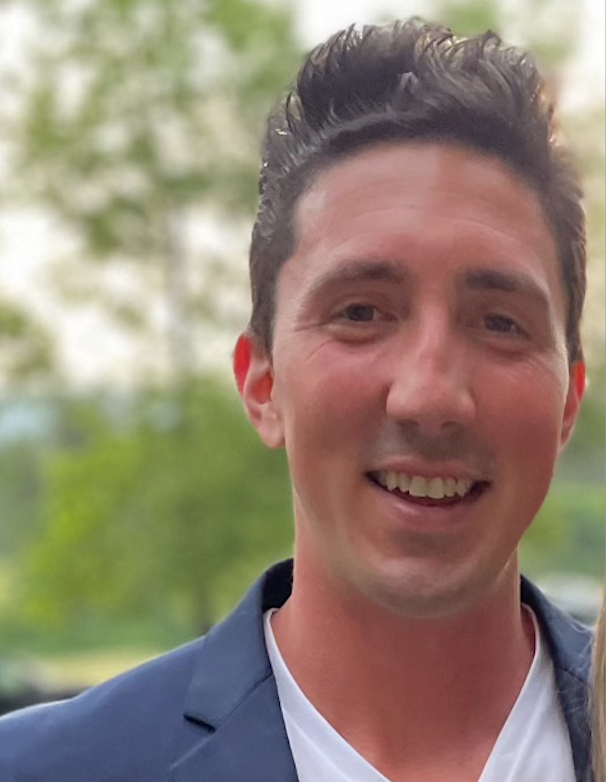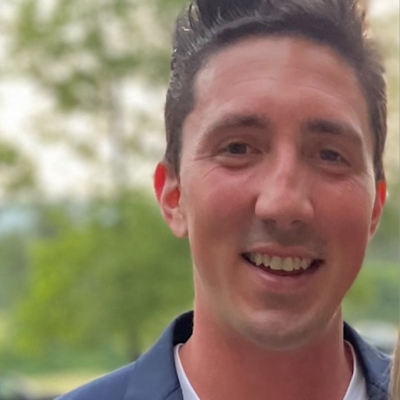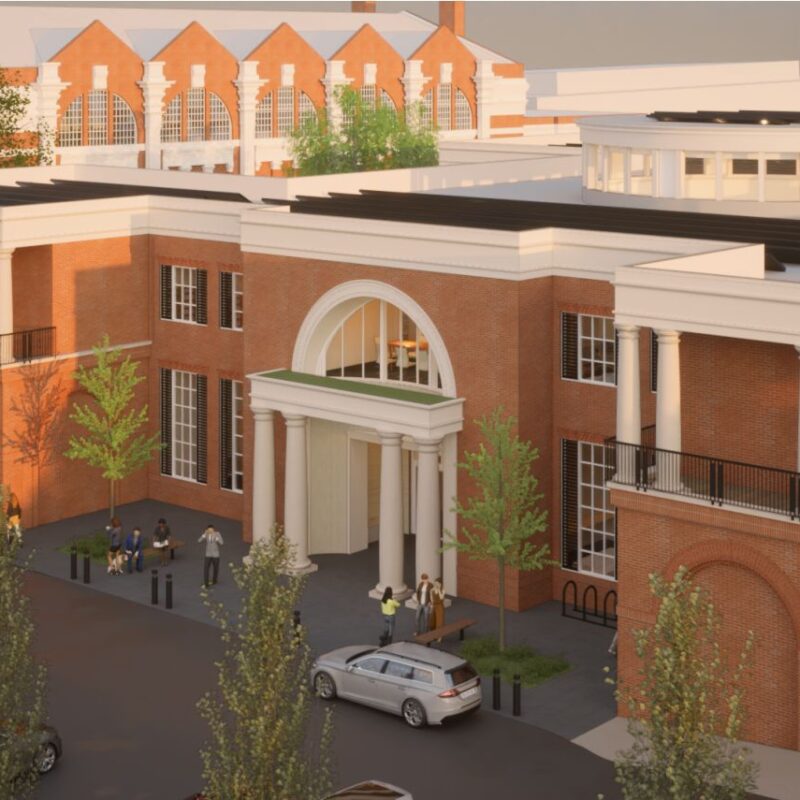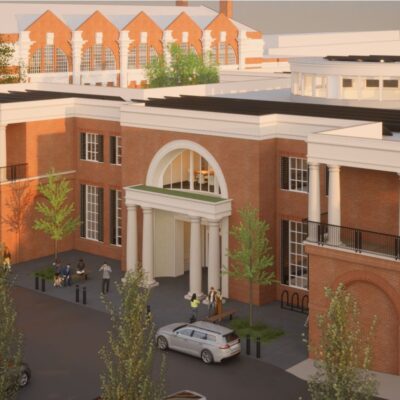It’s a Wednesday night, and in the basement of a converted home at 315 10th St. NE in Charlottesville’s Martha Jefferson neighborhood, seven HIV-positive men are sharing Subway sandwiches and soda and talking about viral loads.
Actually, they’re talking about all kinds of things: growing up as the only black boy in a class of white kids in Martinsburg; the problem with online dating in a small town (“It’s all the same people!”); and, in a somber moment, recollecting the early days of the AIDS epidemic in Atlanta, when hospital wards overflowed with sick men made gaunt by experimental drugs and desperate patients decided that jumping off downtown office buildings was a better way to go.
The weekly support group is organized by Thrive, the organization formerly known as AIDS Services Group (ASG). The men range in age from 22 to 55. Some have had HIV for decades; one was diagnosed just a year ago. They come here for fellowship, they said, and to learn from weekly speakers who talk about everything from HIV care to financial management.
But that’s not necessarily what first brought them in Thrive’s doors. One was homeless, and came seeking help finding a place to live through the group’s federally funded housing assistance program. Another hooked up with Thrive when he was getting out of prison, thanks to another program that helps HIV-positive inmates transition to life after jail.
Their stories are a testament to the fact that the nonprofit that fills the offices and exam rooms on the floors above them during business hours does a lot more than swab cheeks for HIV tests. Like AIDS service organizations (ASOs) across the country, it’s had to adapt to keep pace with a disease that looks very different than it did 30 years ago, but stubbornly persists, and hits poor Southern African-American populations harder than any other.
The nonprofit’s biggest change yet took place in the last year. They’ve broadened the services they offer and become a primary care center open to anyone—straight, gay, 50- year-old mothers of three, 19-year-old college guys—with a special focus on and understanding of groups most likely to be at risk for HIV. It’s about surviving as an institution in a changing health care landscape, but supporters also believe they’re experimenting with a model that could finally move the needle in a stalled fight to reduce the number of HIV infections seen in the U.S. each year.
Moving targets
ASG, now Thrive, was founded in Charlottesville in 1986 in the early wave of grassroots response to the AIDS epidemic. Executive Director Peter DeMartino wasn’t here then, but those who were describe the same suffering and alienation seen in communities across the country.
“When you talk to our founders, you hear some horrific stories about folks coming back to Charlottesville essentially to die,” he said in an interview last year. “Quarantine, nurses in suits, food left outside of the door, people not being bathed or being touched. It was that time in the crisis where people didn’t know. There was a lot of ignorance and a lot of fear.”
Today, effective treatment is as simple as a single pill once a day. The U.S. now spends $3 billion a year on care and prevention, a number DeMartino likes to repeat, as if he’s still getting used to the idea himself. And the face of HIV and AIDS is different, too.
When he started working in advocacy as a young, HIV-positive gay man, ASOs were still primarily run by and for gay men.
Today, he said, “the environment has radically changed.” The impact is spread out across other populations: IV drug users, African-American women. The biggest increases in HIV infection rates are now among young people, DeMartino said, again primarily African-Americans. With every category of marginalization—gay, minority, poor, an addict, homeless, mentally ill—your risk of infection goes up. Trying to control those risk factors would mean taking on a many-headed monster embodying every social justice challenge you can imagine.
Which might explain why prevention efforts have stalled nationwide.
“We’ve kind of flatlined at 50,000 new diagnoses per year in the U.S.,” said Elaine Martin, director of HIV prevention services for the Virginia Department of Health. For a long time, tactics for stopping the spread of HIV had been focused on those who don’t have the disease, she said—it was about awareness and safe sex. But in the face of that stubborn plateau and the reality that prevention dollars aren’t going to go up, there’s been a deliberate shift toward a different approach, Martin said: treatment as prevention.
“Now, rather than work with all these people who are HIV negative, we’re trying to work with people living with HIV,” she said. “We ensure that they know their status, that they’re getting health care”—and as a result, they’re less infectious.
In Virginia, most of the federal funds for treatment, which come from the Department of Health and Human Services-administered Ryan White Program, are directed toward a few major care centers. The problem, said DeMartino, is that not everybody who needs and is eligible for care is getting it. Only about 20 percent of people living with HIV in the Commonwealth—there are about 28,000—are getting their medications paid for through the biggest effort, the AIDS Drug Assistance Program. HIV drugs cost about $15,000 a year, and the program covers it for people whose income is up to 400 percent of the federal poverty line.
“That’s about 23,000 people in Virginia with HIV who are not accessing the $11 million worth of funding that’s coming through,” DeMartino said, which he thinks is a good argument for spreading the resources out more. “If you don’t live anywhere near them, where the hell are you getting your care?”
Even those who do live close to top-notch providers, like UVA Medical Center’s Infectious Disease Clinic, often don’t want to deal with visiting a hospital and seeing an HIV specialist for a routine doctor visit, DeMartino said.
Dr. Rebecca Dillingham, director of UVA’s Center for Global Health, said the infectious disease clinic does primary care and can even take walk-ins, but it’s true that they see a huge number of patients from all over Virginia. Many patients drive on average two hours to get to the clinic.
“We’re trying to be as nimble as we can, and we’re trying to keep providing services we’ve been providing,” but the future is uncertain for the major care centers, too, thanks to the Affordable Care Act. ACA funding is expected to supplant the Ryan White Program in the coming years, and Dillingham and others are concerned that it won’t be a smooth transition, and that some services won’t make the cut.
Filling in the gaps
In many communities, ASOs are the only places offering counseling and other care specifically for people with HIV and AIDS. Many do a lot to knock down barriers to care and address some disease risk factors, steering federal grant money to their HIV-positive clients to help them get housing, mental health counseling, even the gas to get them to and from those far-flung doctors’ appointments. They’re also a place to go to feel less alone.
Shawn Decker knows firsthand how important that can be. Decker was diagnosed in 1987 at the age of 11 after contaminated blood products were used to treat his hemophilia. He was living in Waynesboro, and was given six months to two years to live. He kept his status a secret, and he also stayed alive. The first time he ever sat in a room with other HIV-positive people was at ASG, on the recommendation of his Richmond-based doctor. He was 20.
“It was daunting, but it felt like something I needed to do,” he said, and it was—he found friends, and confronting his own fears was easier. He’s been an outspoken advocate and HIV educator ever since, launching one of the first blogs about living with HIV and, as he puts it, “splashing my status all over the Internet.”
He now lives in Charlottesville with his wife, Gwenn Barringer, and they make a living speaking at schools around the country about awareness and prevention— specifically, how they keep Barringer HIV negative. From their position as educators on a national level, they’ve watched shifts in public perception of the disease and those who have it, and they’ve seen how those shifts affect advocacy work.
A lot of young people aren’t as concerned about contracting HIV now, said Barringer, because a diagnosis isn’t the death sentence it used to be. “Either they don’t know anybody who’s positive or the people they do know are healthy,” she said.
At the other end of the age spectrum are people who have suffered great losses, survived and regained their own health, said Decker. “Who can blame them if they don’t want to go volunteer for the local AIDS organization or sign up for that job?”
That combination of apathy and activist fatigue is eroding the do-something energy that helped launch ASOs and has kept them alive, but it’s not the only factor. Prevention is often a big part of their missions. Martin said many haven’t adapted to the new world of positive-focused prevention, and they’re watching funds go elsewhere.
“My message to community-based organizations was ‘You’ve got to change your model, merge with somebody else, or you’re going to go out of business,’” she said.
That last fate has befallen at least two Virginia ASOs in the last 18 months. The Williamsburg office of the Eastern Virginia AIDS network shut down in May of last year. A month later, the Northern Virginia AIDS Ministry (NOVAM), closed its doors after 25 years.
That’s a problem, said Decker. ASOs have a long history of working to erase the stigma associated with HIV, and we still have a long way to go on that front.
“The public perception of HIV is either ‘It’s no big deal,’ or it’s still ‘I can’t share a glass of water with you,’” Decker said. “It’s insane.” And besides that, “they’re the stopgap between the patient and those things they need to survive,” he said.
So what’s an ASO to do? How can legacy AIDS organizations with relatively small budgets be public health leaders and stay true to their social justice roots?
That’s the environment DeMartino encountered when he arrived at ASG in 2010. His answer to the big questions: Become something other than just an AIDS organization.
‘The bleeding edge’
ASG’s transformation began in earnest in 2013, when DeMartino said staff realized a lot of the talk therapy work they were doing with one of their biggest risk populations—people with mental health issues—was getting undone because their clients were missing medication appointments with their psychiatrists at Region Ten or UVA’s Infectious Disease Clinic. So ASG brought on a psychiatric nurse practitioner who could handle those meds appointments herself.
It was the first step in what became a major institutional shift toward providing “HIV-informed” primary care to anybody who came through their doors. The name change to Thrive was also part of the package: No more direct mention of AIDS.
It was a controversial move. Having “AIDS” on the nonprofit’s letterhead was, for many, a way to push back against the persistent stigma that continues to affect many of their clients, DeMartino said, but it was holding the organization back. Most of the people the group helped didn’t have AIDS, after all, he said, including many who were HIV-positive and actively working to avoid getting full-blown AIDS. If the goal was to normalize HIV-conscious care, DeMartino said, it was time to stop referring to the disease directly.
“Twenty-five years ago putting ‘AIDS’ on the front door meant so much to so many people,” he said. “Now, taking ‘AIDS’ off the front door means even more to more people. Our whole opus, all of our work, is about moving barriers. And if I have a group of people saying to me, ‘AIDS in your name is a barrier,’ I’m going to remove that barrier.”
By “going stealth,” DeMartino said, they’re bringing in more people and alienating fewer of them. Transgender men and women can start hormone therapy. Men with eating disorders finally feel they can speak up to a therapist. Everybody can see a caregiver who “gets” them, DeMartino said, and they don’t have to wait weeks for an appointment. And at the end of the appointment, somebody asks them about whether they want to get a quick HIV test.
The shift to a full-service primary care clinic didn’t come cheap. It’s absorbed approximately $280,000 this year, which amounts to about 18 percent of Thrive’s total budget. All the money for the primary care initiative has come from private donors.
Roberta Williamson, who for a time co-owned the Charlottesville Ice Park, is one of those donors. Her best friend from childhood died of AIDS in 1982, and her sisters, both in the medical field, treated AIDS patients from the early days of the epidemic through the ’90s. The disease broke her heart, she said, but she didn’t get closely involved in local efforts until she met DeMartino and learned what he wanted to do.
“I think it’s a model for the future of health care in this country,” Williamson said: Efficient, understanding care with an eye on prevention. If you doubt there’s a need for it, she said, consider that some gay friends of hers have never told their primary care doctors that they have sex with men.
Cynthia Neff, past president of Thrive’s board of directors, put it this way: “How can you have whole health care if you don’t bring your whole self?”
Neff, a retired IBM executive and former member of the Albemarle County Democratic Party’s steering committee, has been involved in AIDS advocacy work since the ’80s, when she lived in San Francisco and saw dozens of her friends die of “the plague.”
“I lost 60 people before I threw away my address book,” she said.
Before the board got behind the changes, some interns ran an experiment, said Neff. They called doctors’ offices in the city, introduced themselves as HIV-positive, and asked if the practice was accepting new patients. Overwhelmingly, they were told no, they had to go to UVA, said Neff, because “we don’t do AIDS.”
“One doctor’s office said, ‘I guess we could, but you have to give us notice so we can prepare the office,’” she said. It reinforced the need. “We’re backing up and saying we need a place where people can get care and get tested, and along the way, we’re going to talk about some of the hinkier things—sex and behavior and addiction.”
DeMartino said it’s the support of funders and board members like Williamson and Neff that makes it possible for Thrive to be on what he calls “the bleeding edge” of care innovation—like the cutting edge, but not so profitable, and often more painful.
And it’s working, he said. In the nine months since the organization became Thrive, it’s seen an increase in new positives and the number of positive people seeking care.
“I’ve literally had people in tears in my office saying they’re ready to go on meds,” he said, and most of them didn’t come through the door for HIV care. “We are right on the cusp here. We have the right resources in the right community with the right backers, and I think we can do really amazing things. We can be a model.”
And they’re still taking care of people with a disease that 30 years ago made people untouchable, that’s still misunderstood, that still makes people feel cut off and adrift.
Back in the basement conference room, empty sub wrappers drift over the table as the support group’s dinner winds down. A man in his 40s, who asked to go only by the name Andy, has been sitting mostly in silence while the others chatter and laugh. He softly explains that he’s been homeless, and he’s currently out of work. He comes to Thrive for his primary care, he said, but he comes to the support group for something else.
“I can be myself here,” he said. “Outside, I struggle to be who I am.”
Do we do enough to fight the spread of HIV in Charlottesville? Join the conversation in the comments.






